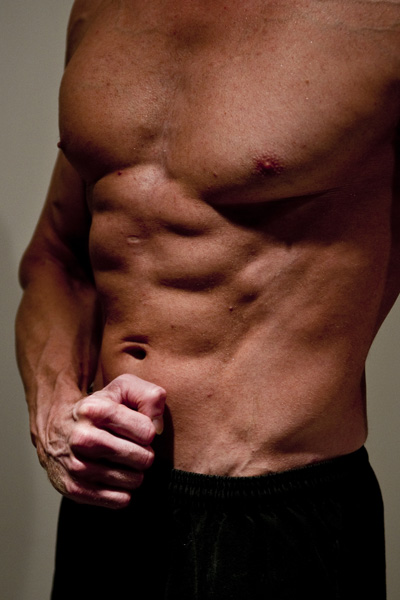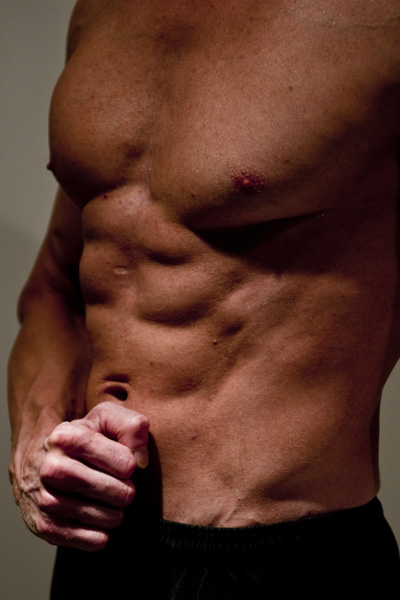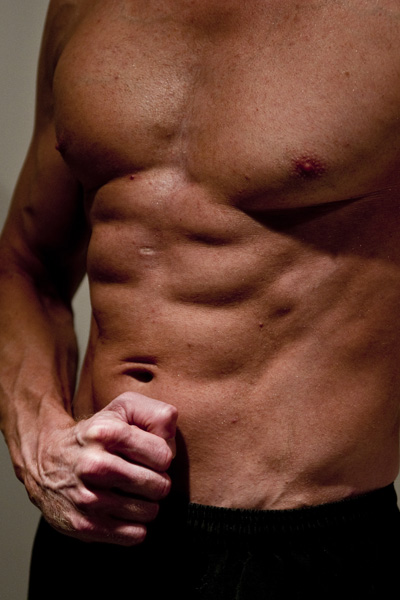 |
||
| |
||
| |
||
| |
||
| |
|
|
| |||||||||||
|
|
|
Build an Impressive Chest
|
|
In addition to this rotating pattern of upper body workouts, I do these:
In these photos, I was at 5% body fat and am still there about 5 weeks later as I write this. In fact, I have been at 5% body fat for about eight months now. I'll probably stay that lean well into the future. One reason I can be that lean is the way I have these workouts scheduled. This kind of scheduling plays off the cortisol/testosterone responses the body goes through when subjected to the kind of stress that an intense workout puts on it. Of course, eating six small meals a day and paying attention to what's in those meals is another factor that allows a 50 year old person to be at 5% body fat. It isn't genes, trust me. If I can do it, anyone else can do it. Chest specificsAs I noted previously, I do only two exercises. I am not saying all other exercises are pointless. I am saying this works for me. It might not always work for me, and if it stops working for me I will change it. What's important to understand is you do not gain a thing by doing all kinds of exercises for a given workout. In fact, you lose intensity that way so you lose the results too. So pick a couple of good exercises, and do them with all your heart. Women tend to do a pretty good job of maintaining form when doing the bench press, but nearly all men utterly fail. Why is this, and what are they doing wrong? For some reason, most men actually care what other people think about how much weight they can lift when benching and thus they cheat the exercise to lift more. This is a misguided, counterproductive concern. Forget about everyone else. It is YOUR chest you're working. Focus on actually working your chest. I'm going to tell you how to do the bench press in proper form. Before you attempt this, reduce whatever you are benching now by 75%. Yes, I am serious. I've seen guys who "work out" with 225 (by cheating), yet are unable to bench 100 lbs in correct form. They have weak chests. They have strong front delts. They have high risk of back injury. Oh, and so I don't get bombarded with e-mails asking this question. I have benched 1.5 times my body weight, in proper form, for eight straight reps. But I don't work out with that weight. I use less weight (about 1.2 times my body weight) and focus on working the muscle instead of lifting weight. I don't know what my max bench press is and I don't care to find out. It just does not matter. Proper form for the bench press:
I typically do a total of 25 to 30 reps. All in low rep sets. Proper form for the flye:
Stacking the workout for maximum effect:I do the above in the morning. I come back in the afternoon and repeat a shorter version of it.
People have remarked, "I can tell you do a lot of cardio, because you're so lean." Wrong. I don't do cardio. The exercise I just described with flyes puts such an enormous load on the body that my heart feels like it's going to come out and I can hardly catch my breath. Now, understand that when I do the spirometer I very quickly put the needle off the chart and hold it there. So, it's not like I don't have lung capacity. Do this exercise and you'll understand my point here. This article touches on the key aspects of building a powerful chest that makes you look powerful. Many people will focus on some minor detail or another, but not properly assemble the big pieces. Now you have a good idea of how the big pieces go together. In our other articles, you'll find the details of exercises and diet. Before you implement those details, put together your total fitness plan based on what you've just read. More chest shots, below. See if you can find what's a little different about each one. Photographer: Aaron Lindberg,http://www.aaronlindberg.com/ |
|
|




Article AuthorshipThe articles on this site are authoritative, because:
Where an article is not bylined with a specific author's name, it was written by Mark Lamendola (see photos on home page and elsewhere on this site). Mark is a 4th degree blackbelt, has not been sick since 1971, and has not missed a workout since 1977. Just an example of how Mark knows what he's talking about: In his early 50s, Mark demonstrated a biceps curl using half his body weight. That's a Jack LaLanne level stunt. Few people can even come close. If you want to know how to build a strong, beautiful body, read the articles here. |
| Supplecity
is a subsidiary of Mindconnection.com. When you follow the links from this
site to the purchase area, you will go to Mindconnection's secure server. If you have any questions, comments, or concerns, please view the aboutus pages, or write to mark @ mindconnection.com. We do want your business. |